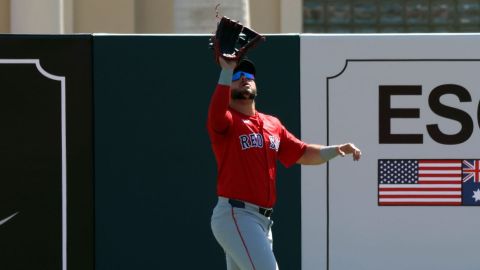As a hitter, Jacoby Ellsbury is your typical center fielder, slapping the ball around the field and using his speed to his advantage. With his move to left field, though, the 26-year-old joins a cadre of former Boston left fielders known more for their power. Could Ellsbury change his game to fit better within that group of sluggers?
See, Ellsbury smacked two home runs during Wednesday's spring training tilt against the Rays. For those watching batting practice on the fields of Fort Myers, his power display is unsurprising. Ellsbury has shown in batting practice that he can crank the ball just as far as the sluggers can.
Batting practice is a far cry from live game action, however. And to be fair, the Red Sox aren't too concerned about Ellsbury's power deficiency. That's not why he's making the big bucks.
Ellsbury is a fine defender who boasts one superior tool to most everyone else in the game: speed. Ellsbury's 70 swiped bags in 2009 paced the competition, with Houston's Michael Bourn's 61 registering second. It's that speed that Boston will expect out of Ellsbury in 2010 as they make a push to win the World Series.
Looking beyond 2010, however, could the fleet-footed left fielder develop more of a power stroke? Power is widely considered by scouts to be the last aspect of a player's game to develop. This is reflected in one of Ellsbury's predecessors in Boston's center field: Johnny Damon.
Over Damon's first two full years with the Kansas City Royals (1996-97), he too failed to crack double digits in home runs while his game revolved around speed, defense and getting on base. (It should be noted that Damon played his first full season at age 22, while Ellsbury did so at age 23.) Damon also failed to hit as many doubles and triples as Ellsbury. Ellsbury also possesses a .291 batting average in his first two full seasons, higher than Damon's .273.
The light switch flipped on for Damon, though, in 1998. He cranked 18 home runs, 30 doubles and 10 triples for an isolated power mark of .162. (ISO is a measure of a hitter's raw power: removing singles from the equation.) Since then, Damon has been able to maintain his power stroke, although he has not appreciably improved it. What he has done is maintain his power stroke into his late-30s as his speed wanes.
Another comparable player is Carl Crawford, the current Tampa Bay Ray who expects to command a major deal in free agency after the season. He made his debut in 2002 as a 20-year-old, and in the following year had just 32 extra-base hits among his 177 overall. Much like Ellsbury and Damon, he showed below-average power despite strong speed and defense. In fact, his ISO was a paltry .081. (To compare, Ellsbury's ISO in 2008 was .114, although the caveat of a difference of two years in age must be applied here as well.) The following year, though, Crawford's power game jumped: 11 home runs, 26 doubles and an impressive 19 triples. Like Damon, he also has not improved his power game since.
In this small sample size of two pre-selected hitters, we see that the beginning of their careers relied primarily on speed and defense, with power arriving later. Despite the small sample, the two hitters represent an overarching, proven trend that players tend to develop power as they enter the prime of their baseball careers.
Ellsbury is unlikely to become another Manny Ramirez, capable of dropping 40 bombs on the opposition. What he's likely to do, however, is tack on several more home runs to his annual totals as the years go by, while retaining the other aspects of his game that make him so valuable today.



